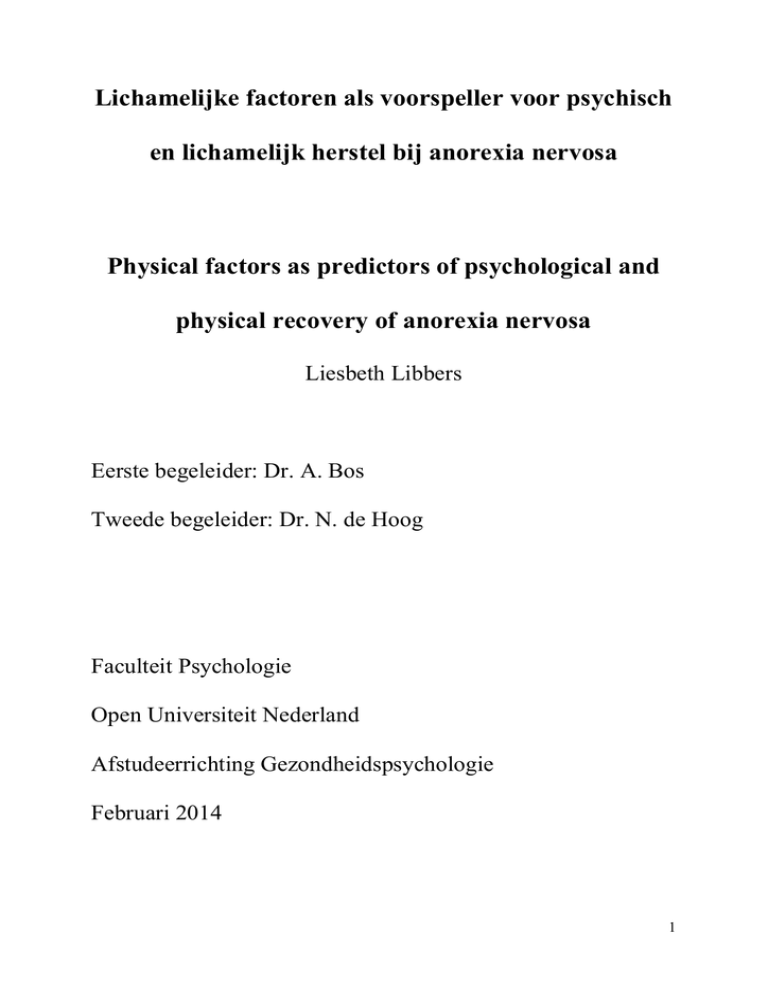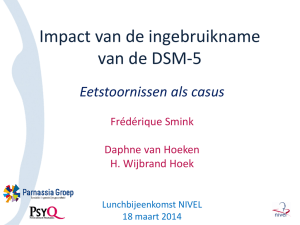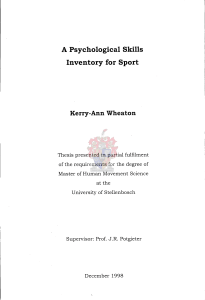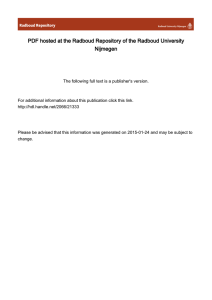Lichamelijke factoren als voorspeller voor psychisch en lichamelijk
advertisement

Lichamelijke factoren als voorspeller voor psychisch en lichamelijk herstel bij anorexia nervosa Physical factors as predictors of psychological and physical recovery of anorexia nervosa Liesbeth Libbers Eerste begeleider: Dr. A. Bos Tweede begeleider: Dr. N. de Hoog Faculteit Psychologie Open Universiteit Nederland Afstudeerrichting Gezondheidspsychologie Februari 2014 1 Inhoudsopgave Samenvatting 3 Summary 4 Inleiding 6 Methode 17 Resultaten 21 Discussie 25 Literatuur 33 2 Lichamelijke factoren als voorspeller voor psychisch en lichamelijk herstel bij anorexia nervosa Samenvatting Inleiding. Herstel van de eetstoornis anorexia nervosa kent lichamelijke en psychische factoren. Dit onderzoek richt zich op lichamelijk herstel als voorspellende factor voor psychisch en lichamelijk herstel bij een patiëntengroep met anorexia nervosa die gedurende tien jaar gevolgd zijn. Er is weinig longitudinaal onderzoek waarbij patiënten zo lang gevolgd zijn. In dit onderzoek worden drie groepen met elkaar vergeleken: patiënten die aan het eind van een behandeling niet hersteld zijn, die gedeeltelijk hersteld zijn en die geheel hersteld zijn. Methode. De onderzoekspopulatie is een groep van 61 vrouwelijke patiënten die maximaal een jaar behandeld zijn in de Rintveld kliniek in Zeist voor anorexia nervosa en tot tien jaar na afloop van de behandeling gevolgd zijn. De data zijn verzameld op het moment dat de patiënten hun behandeling beëindigden, vijf jaar na de behandeling en tien jaar na de behandeling. De deelneemsters zijn onderzocht op lichamelijk en psychisch herstel. De data waren reeds verzameld door de Rintveld kliniek in Zeist en zijn beschikbaar gesteld. Een gezond gewicht is gerelateerd aan lengte en leeftijd. Hiervoor wordt de body mass index gebruikt, een verhoudingsgetal. Herstel van de menstruatie is gemeten door te vragen of de patiënt regelmatig menstrueert. Psychologisch herstel wordt gemeten met behulp van de vragenlijst EDE-Q en het interview EDE. Resultaten. De verwachting was dat er verschillen te vinden zouden zijn na vijf en tien jaar op grond van de oorspronkelijke indeling in groepen (volledig hersteld, gedeeltelijk hersteld, niet hersteld). In dit onderzoek komt naar voren dat de groepen alleen in leeftijd significant van elkaar verschilden bij follow-up. De groep die aan het eind van de behandeling hersteld was, 3 blijkt gemiddeld iets ouder. De groepen verschillen niet significant van elkaar bij follow-up op body mass index en vetpercentage. Ook verschillen ze niet significant van elkaar op psychologisch herstel. Discussie Aan de hand van de resultaten zijn geen voorspellers gevonden voor lichamelijk en psychologisch herstel na vijf of tien jaar. Na een behandeling voor anorexia nervosa kunnen andere factoren een rol spelen in het al of niet herstellen van de eetstoornis. In vervolgonderzoek is het aan te bevelen om factoren als life events te meten, patiënten gedurende een langere tijd regelmatiger te volgen in hun herstelproces en eventuele verdere behandelingen en om naast lichamelijke factoren standaard psychische factoren te meten. Keywords: anorexia nervosa; lichamelijk herstel, psychologisch herstel, follow-up, body mass index, Eating Disorder Examination. 4 Summary Introduction. Recovery of anorexia nervosa has physical and psychological aspects. This research focuses on physical recovery as a predictive factor for psychological and physical recovery in a patient group with anorexia nervosa that are followed for ten years. There is limited longitudinal research in which patients are followed for so long. Three groups are compared in this study: patients who are not recovered after their treatment, patients who are partially recovered and patients who are fully recovered. This allows for possible predictions to be made for physical and psychological recovery. Method. The study population is a group of 61 female patients who were treated for anorexia nervosa for up to one year in the Rintveld clinic in Zeist. They were followed for ten years after the end of the treatment. Data were collected at the time the treatment started, at the end of the treatment, five years and ten years after the treatment ended. Physical and psychological recovery were studied. The data were already collected by the Rintveld clinic and made available. A healthy weight is related to height and age. This is the body mass index ratio. Recovery of menses was measured by asking whether the patient is menstruating regularly. Psychological recovery was measured by using the questionnaire EDE-Q and the interview EDE, which stands for Eating Disorders Examination. Results. Expectations were that the groups would differ after five and ten years, based on the original grouping (fully recovered, partially recovered, not recovered). No significant results were found for body mass index, body fat or psychological recovery. The only difference found was the group of patients who were fully recovered after the treatment were significantly older than the other groups. Discussion. Based on the results no predictors for physical and psychological recovery have been found after five and ten years. Other factors may play a role in whether a patient will 5 recover fully or not. For further research it is recommended to include life events as predicting factors, to follow patients for a longer time on a regular basis in their recovery process and during other treatments and to measure psychological factors as a standard method. 6




